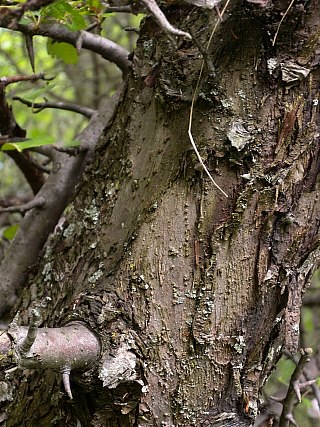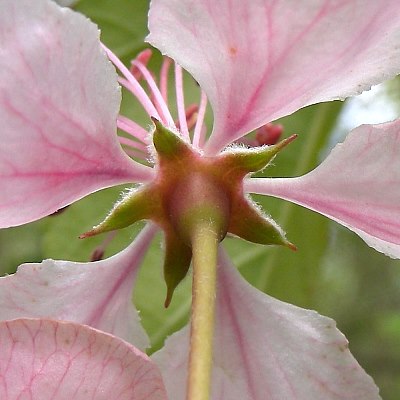Description: This small tree is 15-25' tall at maturity. It has a short trunk that is often crooked and a broad irregular crown. The trunk bark is variable, but it is often reddish gray-brown, rough-textured, and covered with longitudinal scales that often curve. Sometimes the trunk bark is more flat and less developed. The bark of branches is reddish brown or dark reddish gray and smooth. Along the larger branches, thorny side branches often develop. The blades of the alternate leaves are 1½-3" long and ¾-2" across; they are more or less ovate, coarsely toothed, and often shallowly cleft. The upper blade surface is yellowish green to bright green and hairless, while the lower surface is pale green and hairless (or nearly so, except for very young leaves). The slender petioles are ¾-2" long, light green to bright red (often the latter), and hairless to nearly hairless.

Cymes of 2-6 flowers are produced from short spur-like branches. Individual flowers are 1-1¾" across, consisting of 5 pink petals (often becoming white with age), a green to reddish green calyx with 5 narrowly triangular lobes, a pistil with 5 styles, and 10-20 stamens. The exterior surface of the calyx (facing away from the petals) is smooth and hairless, while its interior surface is densely covered with appressed silky hairs. The slender pedicels are 1-2" long and hairless to nearly hairless. The blooming period occurs from mid- to late spring and lasts about 2 weeks. The flowers have a pleasant fragrance. Fertile flowers are replaced by a globoid fruit (pome) that is ¾-1½" across. The fragrant fruit is initially green, but it later becomes yellowish green or yellow at maturity; its surface is smooth and waxy. The hard flesh of the mature fruit is slightly juicy and sour-tasting; it contains several seeds toward the center of its interior. The root system is woody and branching, sometimes producing underground runners that form clonal offsets.

Cultivation: The preference is full or partial sun, moist to dry-mesic conditions, and soil containing loam or clay-loam. This small tree is vulnerable to a variety of insect pests and foliar disease organisms. It should not be planted near Juniperus virginiana (Red Cedar), which can spread cedar-apple rust.
Range & Habitat: The native Wild Crab Apple is occasional in southern Illinois and uncommon or absent in the central and northern sections of the state (see Distribution Map). Habitats include open woodlands, woodland openings, woodland borders, savannas, and thickets. Wild Crab Apple can be found in both upland and bottomland areas where other deciduous shrubs and trees are present, particularly where there has been some disturbance to reduce the overhead canopy of dominant trees.

Faunal Associations: The fragrant flowers are cross-pollinated by honeybees, bumblebees, mason bees (Osmia), digger bees (Synhalonia), Halictid bees (including green metallic bees), Andrenine bees, butterflies, and skippers. The bees suck nectar and collect pollen, while the butterflies and skippers suck nectar only (Robertson, 1929; Wilhelm & Rericha, 2017). Other insects feed destructively on various parts of crab apple trees, including the wood, leaves, sap, and fruit. Generally, these insect feeders include the larvae of wood-boring beetles, weevils, scarab beetles, fruit flies, plant bugs, aphids, leafhoppers, treehoppers, armored scales, mealybugs, larvae of sawflies, larvae of many species of moths, and larvae of butterflies, such as the Striped Hairstreak (Satyrium liparops). The eight-legged Apple Rust Mite (Aculus schlechtendali) usually feeds on the undersides of leaves. For more complete inforamation, see the Insect Table. Among vertebrate animals, some birds and mammals feed on fruits of crab apple trees. The size of crab apple fruits can influence what kinds of vertebrate animals consume them (birds favoring smaller fruits, mammals favoring larger fruits). Example of birds that peck at the fruits or consume them include the American Crow, Blue Jay, Baltimore Oriole, Orchard Oriole, Ruffed Grouse (also eats buds & leaves), Ring-necked Pheasant, Red-headed Woodpecker, Downy Woodpecker, Monk Parakeet, Carolina Parakeet (now extinct), European Starling, Purple Finch (also eats buds), and various thrushes (Turdidae); see DeGraaf (2002), DeVore et al. (2004), Martin et al. (1951/1961), and Beal (1915b). Mammals that eat the fruits include the Gray Fox, Red Fox, Opossum, Fox Squirrel, American Black Bear, and various voles (Microtus). Elk and White-tailed Deer browse on the twigs and leaves (less often, the fruits), while the American Porcupine and Cottontail Rabbit gnaw on the bark and inner bark (Martin et al., 1951/1961; Sotala & Kirkpatrick (1973); Schneider et al., 2006; Haugen, 1942; Beeman & Pelton, 1980). In addition to food, Crab Apple trees provide cover and nesting sites for many kinds of birds, including the Field Sparrow, Blue Jay, Orchard Oriole, Eastern Screech Owl, European Starling (uses cavities for nests), Ruby-throated Hummingbird, Eastern Bluebird (uses cavities for nests), American Robin, Eastern Kingbird, and Red-eyed Vireo (DeGraaf, 2002; Best, 1978; Belthoff & Ritchison, 1990).
Photographic Location: A thicket near the Maumee River in NW Ohio.

Comments: Other common names of Malus coronaria are American Crab Apple and Sweet Crab Apple. The latter name probably refers to the fragrance of the flowers or fruit, rather than the taste of the fruit, which is sour. This small tree is quite attractive during the spring when its relatively large flowers are in bloom. There is a narrow-leaved variant of Wild Crab Apple, Malus coronaria dasycarpa, that can be found in southern Illinois. Another native species, Malus ioensis (Prairie Crab Apple), differs from Wild Crab Apple by having leaf undersides, petioles, pedicels, and calyx exteriors that are conspicuously hairy. Most cultivated apples and crab apples can be distinguished from the preceding native crab apples by the lack of thorns on their branches and lack of cleft lobes on their leaves. Many of these cultivated species have originated from Eurasia or East Asia, and they occasionally escape into both disturbed and natural areas, especially around suburbs and cities.